
Class Asteroidea
Order Velatida
Family Solasteridae
ROSE STAR
Crossaster papposus (Linnaeus, 1767)
Identification:
8 to 16 arms, but usually 11. Aboral surface with numerous, raised tufts of small spines. Variable aboral colour, often with concentric patterns of red, orange, white or yellow, but occasionally one colour overall. Oral surface pale. To 17 cm (6 in) across in British Columbia, but significantly larger (to 30 cm (11.8 in)) in Alaskan and Arctic waters.
Range:
Circumpolar: in the Pacific to Washington State and the Sea of Okhotsk. In the Atlantic south to 40° N latitude on the American coast. Also in Scandinavia and the British Isles in northern Europe. Intertidal to 1,200 m (3,937 ft).
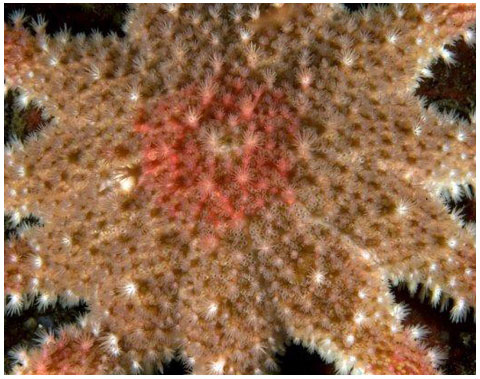

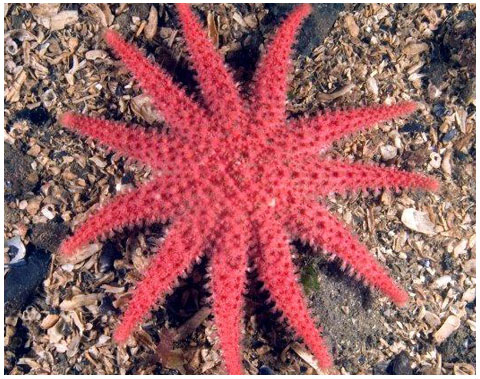
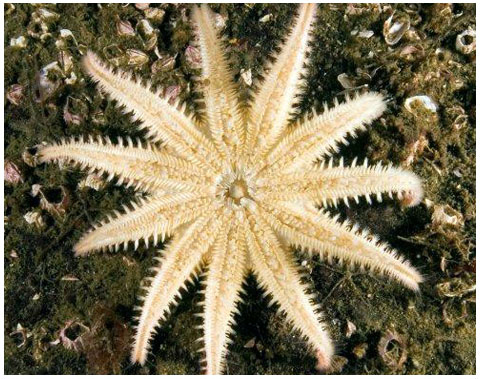
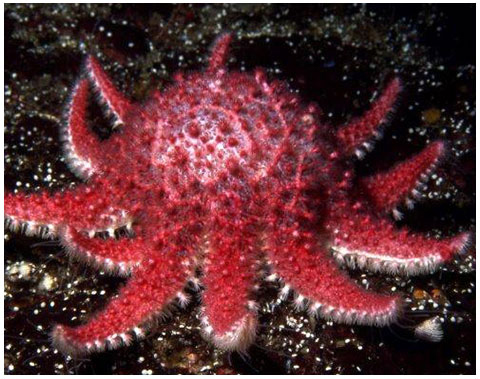


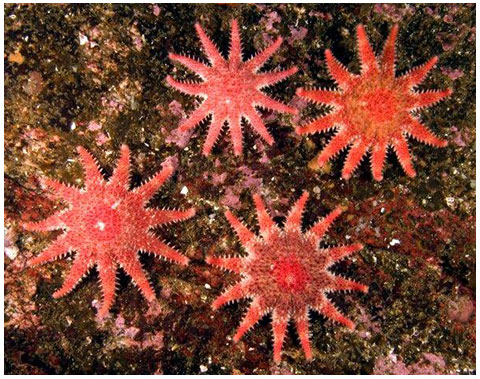
A close-up view showing the distinctive tufts of very small but sharp spines. Interspersed are the thin-walled, finger-like gills.
The spiny surface and concentric rings of colour are typical of the ROSE STAR.
ROSE STARS with only one colour overall are not as common.
The oral side of the ROSE STAR is pale. Note the central mouth, surrounded by long spines.
When feeding, the ROSE STAR humps its body to envelop its prey.
An attractive specimen with concentric rings of colour.
Another colour combination.
No two are exactly alike, it seems.
8 - 8
Previous
NEXT
Notes:
Eats a variety of prey including orange sea pens, nudibranchs, bryozoans, tunicates and bivalves. Often "humps up" when eating prey. This attractive star has been called the "snowflake star" because of its tremendous variety of colours and patterns. It seems quite literally that "no two are alike." It is very common in some BC mainland fjords, notably Jervis and Sechelt Inlets, where dozens of relatively small specimens (generally less than 15 cm (6 in)) can be seen on a single dive. Due to its rich but often dark colours, it is very helpful to take along a good handlight in order to reveal their beautiful patterns.
The ROSE STAR is one the quickest stars on the Pacific coast. In lab tests I clocked it at 50 cm/min, taking the Bronze Medal behind the uber-fast SAND STAR and the fleet-of-tube-foot SUNFLOWER STAR. On this coast I haven't observed it eating other sea stars although it has been reported to attack the MOTTLED STAR. In lab tests most SUNFLOWER STARS reacted to touch by the ROSE STAR as if were a MORNING SUN STAR, so perhaps the ROSE STAR is a legitimate threat or exudes a protein that is similar to the known sea star hunter.
I rarely find the MORNING SUN STAR with a captured ROSE STAR and suspect the latter is able to outrun the sea star hunter on most occasions.
The question of how long sea stars can live is often asked. Little research has been done in this direction, however a ROSE STAR apparently lived for 20 years in an aquarium where it likely did not have to worry about marauding MORNING SUN STARS! The late Dr. Richard Carlson of the Auke Bay Lab in Alaska studied a population of these stars for 17 years. He found that growth rates were quite slow, with individuals reaching a maximum size of 30 cm (12 in) in about 10 years.
INTRODUCTION | ABOUT SEA STARS | BIOLOGY | SPECIES | PREDATORS / PREY | SEA STAR WASTING DISEASE | ACKNOWLEDGEMENTS | FIELD GUIDE | VIDEO
Copyright © 2018 All rights reserved.